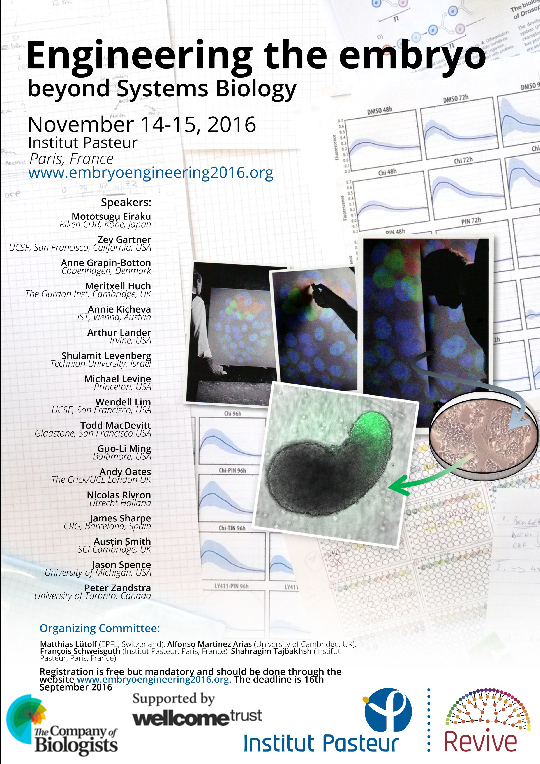A meeting was held recently at the Pasteur Institute on the topic “Engineering the embryo: beyond Systems Biologyâ€. The event brought to my mind a question I pose to the final year undergraduate class: how should we approach a biological problem? like physicists or like engineers? The relationship between Physics and Biology has a long and very distinguished history, strewn with technical contributions that have often changed the direction and pace of biological research. Microscopy and X-ray crystallography would not have happened without the intervention of the physicists. To see this you don’t need to go further than the 2014 […]
Continue readingCategory: News
Preprints in the Biomedical Sciences: The Future is Here
A few days ago, fittingly in the context of Open Access week, we had an event to explain what are preprints and how they have the potential to change communication and career development in the biomedical sciences. You can follow the recording here: https://asapbio.org/event/preprints-biomedical-science-publication-in-the-era-of-twitter-facebook. The event counted on the participation of publishers, funders and users; a summary has been posted in The Node and I encourage you to look at it and contribute to the discussion. There is much to talk about in the wake of the event. Here I shall concentrate on a few issues in the context of […]
Continue readingChristian gone to Dortmund
Good luck Christian in Dortmund and good luck to Meritxell in inheriting Christian’s spot in the lab.
Continue readingWe’re back!
Having survived Blue Monday, it’s back to business as usual in the lab. Here we have Christian and Meritxell hard at work in Tissue Culture (we’re not sure about the rest of the lab…) Happy New Year everyone!
Continue readingNew publication on “symmetry breaking in ensembles of ES cellsâ€
New publication on “symmetry breaking in ensembles of ES cells†Progress on our attempts to understand the connection between genes, signals, cells and embryos have just been published in Development. In a first paper we describe a new experimental system in which we coax mouse Embryonic Stem cells to make structures with an anterior posterior axis and a germ layer organization that resembles that of an embryo (https://dev.biologists.org/content/141/22/4231.full). In a second paper we use this experimental system to gain some insights into the emergence of the spinal cord (https://dev.biologists.org/content/141/22/4243.full). You can see a movie and some thoughts on the experiments […]
Continue readingPublish: What? Why? Where? How?
There are now videos of both the lecture and the subsequent panel discussion available at www.responsibleresearch.graduatecenter.uni-muenchen.de/presentations/videos/index.php
Continue readingFarewell to Pedro Machado
Yesterday we wished farewell to Pedro Machado, a young physicist who has been in the lab for the last few years, educating us in the use of measurement and theory to understand biological systems. Pedro came to Cambridge four years ago fresh from a PhD in Holland on quantum gravity and a great interest in understanding the emergent properties of cells within tissues. At the time Nicole Gorfinkiel had started a trip trying to put some physics in the process of ‘dorsal closure’, a morphogenetic event at the end of Drosophila embryogenesis we had been working on for some […]
Continue readingNew Publication: “Quantifying ES cells: A ß-catenin driven protein interaction network that buffers Oct4 to maintain pluripotency”
Muñoz-Descalzo, S., Rue, P., Faunes, F., Hayward, P., Jakt, L.M., Balayo, C., Garcia Ojalvo, J. and Martinez Arias, A. (2013) A competitive protein interaction network buffers Oct4-mediated differentiation to promote pluripotency in embryonic stem cells. Mol. Sys. Biol. 9 Article number: 694  doi:10.1038/msb.2013.49 https://www.nature.com/msb/journal/v9/n1/full/msb201349.html Pluripotency refers to the property of a cell population to give rise to all cell types of an organism. Embryonic Stem (ES) cells are pluripotent and are able to self renew this property in culture. ES cells have become an important focus of research. From the biomedical point of view because they hold a promise for regenerative […]
Continue readingCongratulations to Naomi Moris
Congratulations are in order to Naomi Moris, a PhD student in the lab, who has won the 2013 EuroStem non-fiction competition https://www.eurostemcell.org/getting-ball-rolling-naomi-moris
Continue readingNews – AMA Lab retreat at Clare Hall Cambridge
Last Friday we had what they called a ‘retreat’, a day out to get a view of what we all do in the lab. It is true that there are lab meetings but one of these events allows us to get a global view of the activities of the group. Given our interest in heterogeneities, it is not surprising that we are a number of variations on a theme: how cells make decisions and how we can bridge this at several scales. We also are pleased to have a number of important collaborations and contributions from outside the lab, which […]
Continue reading

